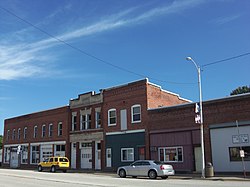Nichols, IA
| Nichols, Iowa | |
|---|---|
| City | |
 |
|
 Location of Nichols, Iowa |
|
| Coordinates: 41°28′45″N 91°18′30″W / 41.47917°N 91.30833°WCoordinates: 41°28′45″N 91°18′30″W / 41.47917°N 91.30833°W | |
| Country |
|
| State |
|
| County | Muscatine |
| Area | |
| • Total | 0.23 sq mi (0.60 km2) |
| • Land | 0.23 sq mi (0.60 km2) |
| • Water | 0 sq mi (0 km2) |
| Elevation | 633 ft (193 m) |
| Population (2010) | |
| • Total | 374 |
| • Estimate (2016) | 372 |
| • Density | 1,626/sq mi (627.8/km2) |
| Time zone | Central (CST) (UTC-6) |
| • Summer (DST) | CDT (UTC-5) |
| ZIP code | 52766 |
| Area code(s) | 319 |
| FIPS code | 19-56685 |
| GNIS feature ID | 0459517 |
Nichols is a city in Muscatine County, Iowa, United States. The population was 374 at the 2010 census. It is part of the Muscatine Micropolitan Statistical Area.
The original name of the site of the current town was Railroad Addition. The town was later referred to as Nichols Station in reference to the previous holder of the town's site. Nichols was named by the early settler Benjamin F. Nichols in honor of his father, Samuel Nichols, who was instrumental in bringing the railroad to the area. Samuel Nichols was a heavy investor in the Burlington, Cedar Rapids and Northern Railroad Company as well as owner of large landholdings. Samuel Nichols had given the rail company the right of way to construct the rail line across his land, as well as to establish a depot at the current site of Nichols.
Nichols was established in the early 1870s in an area of Section 15 of Pike Township known locally as Elephant Swamp. The community was intended as a rail town for the shipment of agriculture products and furs to distant markets, and had been constructed on land donated to the rail company by Samuel and Benjamin Nichols with the intention of establishing a rail depot. The lots for the future community were surveyed by county surveyor George Bumgardner in June, 1871. Two rail lines would eventually run through the town – the Muscatine & Western Railroad and the Burlington, Cedar Rapids and Northern Railroad – which were both branches of the Rock Island system. The first rail line and rail depot was constructed in the early 1870s. Dr. S. H. Smith constructed the first building on the future site of Nichols in 1871, which Mr Smith used as both a drug store and as a home. Construction on the Muscatine & Western Railroad reached the site in 1873, and the rail company laid out an addition to the town, calling it Railroad Addition. At first many of the buildings and homes in the community were log cabins, which were then replaced by more permanent brick buildings. Benjamin Nichols established the first post office in 1870 and served as the first postmaster. The first school was built in 1872. In the winter of 1873-1874 a Christian church was organized with services being held in schoolhouses until the construction of the church in 1874, with services being conducted by Rev. John Powell. The German Evangelical Protestant Church was organized in 1874 by Rev. K. F. Obermann. The Catholic church – Church of St. Mary - was built in 1874 with Father Nicholas Dugan serving as its first pastor. A Methodist church was organized in 1875 by J. A. Bolton. The town soon grew with the addition of several banks, an opera house, and a town hall that had been constructed in 1897. The early economy of the community centered on the two rail lines that ran through the community as well as the buying and shipping of furs as well as agriculture. The Foley and Brugman Brothers operated two large grain elevators which held 15,000 bushels each. Cattle and hogs were also shipped out to markets through the rail lines.
...
Wikipedia
